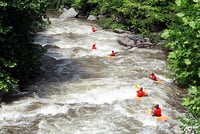
Cheoah River Restoration Report Released - Thumbs Up!
Over the past few years, state and federal resource agencies collected physical and biological data to investigate the effect of minimum flows and ramping rates on aquatic resources in the bypassed reach of the Cheoah River. Most physical and biological monitoring took place before, during and after high flow events in May and July 2007 and May 2008. Physical data collected included flow and temperature from the USGS gage; water depth (level logger) data at selected instream flow study transects used during relicensing; and resurveying the bottom profile of selected transects. Biological data included visual observations and photographs of fish nests; measurements of depth, velocity and size of fish nests; level logger data at fish nests; running the instream flow habitat model (PHABSIM) to assess the effects of ramping, and collection of larval fish in phytoplankton (drift) nets.
The results of these investigations are:
- Little to no change in channel shape
- There was no appreciable difference in the overall appearance of the river channel before and after the High Flow Events (HFEs).
- Most chub nests also appeared to be unaltered by HFEs. As nearly all chub nests were associated with some structure in the channel which provided a velocity shelter, it did not appear that the scheduled HFE flows of approximately 1,000 cfs resulted in any physical damage while being observed by Resource Agency personnel.
- Fry and small fish were found in the same locations before and after the HFE.
- Some sunfish/smallmouth bass nests appeared to be directly affected by high flow
conditions,
mainly by deposition of sand on top of the nest depression. Sunfish nests appear to be more vulnerable to the effects of an HFE than chub nests. However, nest guarding species, like sunfish, should be able to clean small amounts of sediment from their nests by fanning their nests. - Some fish were observed stranded in ‘potholes’ in bedrock prior to the HFE. It is
not known if
these fish were stranded due to a previous scheduled HFE or a natural high flow. - Measurements of nest diameter and height taken before and after HFEs showed little to no
difference in size and shape of most chub nests. - On average, depths at the chub nests increased about 0.3 feet, while mean column velocities and nose velocities increased on average about 0.1 fps (Table 2). Similar small increases in depth, mean column velocity and nose velocity were also found for sunfish nests (Table 3) and fish fry (Table 4).
- A total of 15 drift net samples were taken during base flow conditions, 3 samples under ramping flow (100 cfs) conditions, and 11 samples under high flow conditions. Larval fish or eggs were collected in 3 of the base flow samples and 3 of the high flow samples. Although sampling was limited, there was no strong indication that the high flows were flushing large numbers of small fish or eggs.
This report definitively finds that the high flow events that paddlers use on the Cheoah River have no significant biological or stream channel impacts that need to be addressed. Of course, the study failed to address the many benefits the flow regime is having (flushing fine sediment, controlling vegetation encroachment, selecting for native species, etc). Still, this report is a hallmark of the high value and benign nature of high flows in the Cheoah River.
Based on this report, it is now possible that flows could be tweaked to maximize environmental benefits in a manner that enhances recreational enjoyment. Of particular interest is a finding (in Table 13) that the high overnight flows currently required between releases may be better allocated to other times or days. This water could potentially be used to increase some peak flows or add additional release days. American Whitewater is very pleased that the releases on the Cheoah are a good thing for the river, as predicted, and will continue to work to restore the Cheoah River.
Read the report here.
